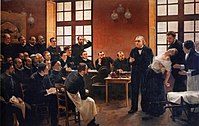
Photo from wikipedia
The cognitive processes involved in cigarette cravings include an attentional bias to smoking cues. In this study, the authors examined whether hypnotic suggestion could be used to modify cravings, and… Click to show full abstract
The cognitive processes involved in cigarette cravings include an attentional bias to smoking cues. In this study, the authors examined whether hypnotic suggestion could be used to modify cravings, and attention via the smoking Stroop task. In the smoking Stroop task, participants are required to name the color of smoking-associated words (e.g. cigarette) and neutral words (e.g. furniture). Attentional bias is measured as the difference in reaction time to name the colors of these two types of words. Thirty-three adult smokers (minimum of five cigarettes per day) were recruited to participate in this study. The counter-balanced, within-subject design had individuals complete the classic and smoking Stroop test the first time either with or without receiving the hypnotic suggestion. Measures of cravings to smoke were assessed. The hypnotic suggestion used was that described by Raz et al. in their 2002 study exploring the use of hypnosis to modulate Stroop performance – that the words displayed on the computer screen for the Stroop task would appear as gibberish. Finally, participants were assessed for hypnotizability with the Stanford Scale of Hypnotic Susceptibility, Form A. While neither the hypnotic suggestion nor hypnotizability was found to affect Stroop task performance, hypnotizability was associated with decreased cravings. Individuals with higher hypnotizability experienced lowered cravings with the hypnotic suggestion. As the authors point out, hypnotizability can then be used to identify individuals whose cigarette cravings can be reduced. However, since no craving-specific suggestion was administered, perhaps the mechanism responsible for the reduction was the lowered stress associated with hypnotic relaxation. It would be interesting to know whether craving-specific suggestions could affect performance on the smoking Stroop task. Address for reprints: Jared W. Bollinger, Department of Medical and Clinical Psychology, Uniformed Services University of the Health Sciences, Bethesda, MD, USA. E-Mail address: jared.w. [email protected]
Journal Title: American Journal of Clinical Hypnosis
Year Published: 2020
Link to full text (if available)
Share on Social Media: Sign Up to like & get
recommendations!